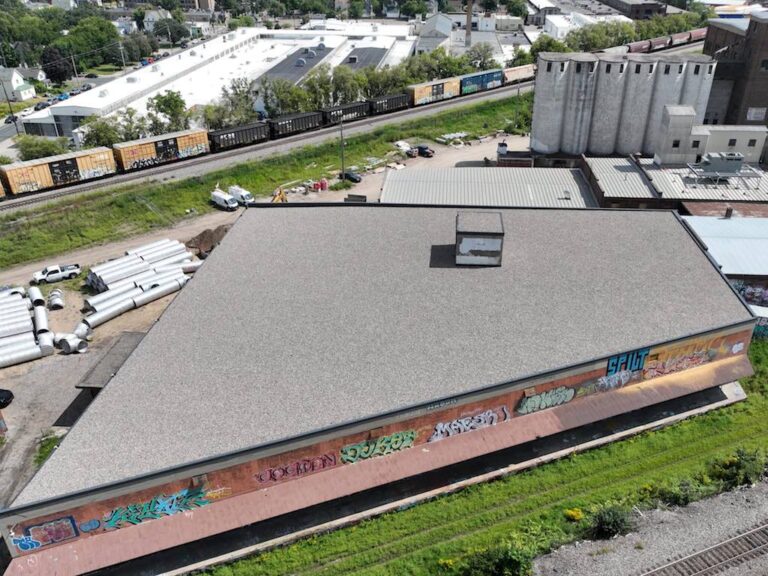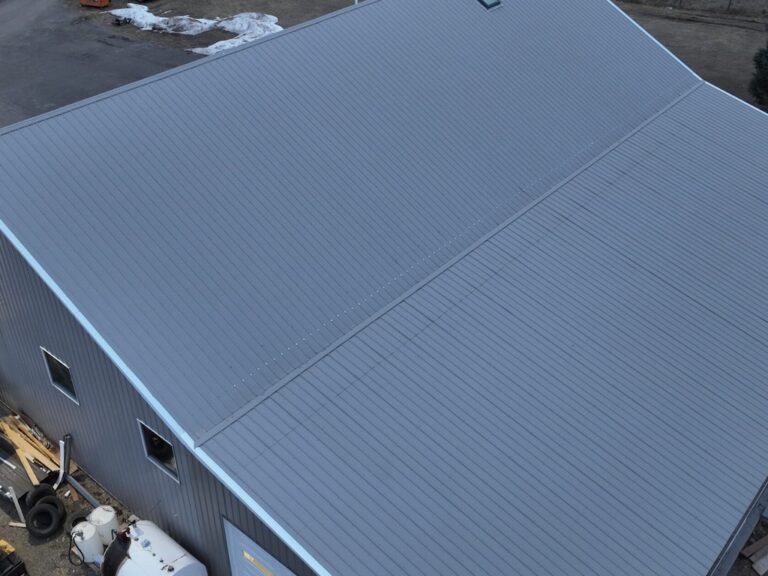The roofing industry is experiencing a technological revolution that’s changing how we protect, power, and maintain our homes and buildings. From solar integration to smart sensors, these innovations are making roofs more durable, efficient, and environmentally friendly than ever before. Whether you’re a homeowner planning a roof replacement or a contractor looking to stay ahead of the curve, understanding these cutting-edge roofing technologies is essential.
In this comprehensive guide, we’ll explore nine groundbreaking roofing technology trends that are reshaping the industry and what they mean for your next roofing project.
Solar Roofing Integration: Beyond Traditional Panels
Solar Shingles and Tiles
Solar shingles represent a major leap forward in residential solar technology. Unlike traditional solar panels that sit on top of your existing roof, solar shingles replace conventional roofing materials entirely. These innovative products look remarkably similar to standard asphalt or slate shingles while generating clean electricity for your home.
The latest solar shingles offer improved efficiency ratings, with some products converting up to 22% of sunlight into usable electricity. They’re also more durable than ever, with warranties extending 25 years or more. For homeowners concerned about aesthetics, solar shingles provide a low-profile alternative that maintains curb appeal while reducing energy costs.
Building-Integrated Photovoltaics (BIPV)
Building-integrated photovoltaics take solar integration even further. BIPV systems incorporate solar technology into the building envelope itself, turning the entire roof into a power-generating surface. These systems are particularly popular in commercial construction, where large roof surfaces can generate substantial amounts of electricity.
The financial benefits of solar roofing continue to improve as well. Federal tax credits, state incentives, and declining installation costs make solar roofing more accessible than ever. Many homeowners see a return on investment within 7-12 years, with decades of free electricity to follow.
Cool Roofing Technology: Reflecting Heat and Saving Energy
Cool roofing technology uses highly reflective materials to minimize heat absorption, keeping buildings cooler and reducing air conditioning costs. This trend has gained significant momentum as energy efficiency becomes increasingly important for both environmental and economic reasons.
Advanced Reflective Coatings
Modern cool roof coatings utilize advanced infrared-reflective pigments that bounce solar radiation back into the atmosphere before it can heat your building. These coatings can be applied to various roofing materials, including metal, single-ply membranes, and even asphalt shingles.
The results are impressive. Cool roofs can reduce surface temperatures by 50-60 degrees Fahrenheit compared to traditional dark roofing materials. This translates to significant energy savings, with many building owners reporting 10-30% reductions in cooling costs.
Cool Roof Color Technology
Historically, achieving maximum reflectivity meant choosing light-colored or white roofing. However, new pigment technologies allow manufacturers to create cool roof products in darker colors, including grays, blues, and even blacks. This innovation gives property owners more design flexibility without sacrificing energy efficiency.
The environmental benefits extend beyond individual buildings. Cool roofs help reduce the urban heat island effect in cities, where concentrated dark surfaces raise ambient temperatures. This community-level benefit has led many municipalities to encourage or require cool roofing in new construction and renovation projects.

Drones and Aerial Inspection Technology
Drone technology has revolutionized roof inspections, making them safer, faster, and more accurate than traditional methods. Roofing contractors are increasingly adopting drones equipped with high-resolution cameras and thermal imaging sensors to assess roof conditions without risking worker safety.
Enhanced Safety and Efficiency
Traditional roof inspections require workers to climb onto potentially damaged or unstable structures, creating safety risks. Drones eliminate this danger while providing more comprehensive data. A drone can capture detailed images of an entire roof in minutes, compared to hours of manual inspection time.
Modern roofing drones carry sophisticated camera systems that capture 4K video and high-resolution photos. These images can be analyzed immediately or archived for future comparison, making it easier to track roof deterioration over time.
Thermal Imaging and Moisture Detection
Advanced drones equipped with thermal imaging cameras can detect moisture infiltration, insulation gaps, and heat loss that aren’t visible to the naked eye. This technology identifies problems early, before they cause serious damage, saving property owners thousands in repair costs.
The data collected by drones also improves estimate accuracy. Contractors can measure roof dimensions, calculate material quantities, and identify potential challenges without multiple site visits. This efficiency reduces project costs and speeds up the bidding process.
Smart Roofing Systems with IoT Sensors
Leak Detection Sensors
Water intrusion is one of the most destructive roofing problems, often causing extensive damage before it’s noticed. Smart leak detection sensors can identify moisture within minutes of intrusion, triggering immediate alerts via smartphone apps or building management systems.
These sensors are particularly valuable in commercial buildings, where large roof surfaces make visual inspection challenging. Early leak detection prevents secondary damage to inventory, equipment, and building interiors, potentially saving hundreds of thousands of dollars.
Environmental Monitoring
Advanced smart roofing systems monitor multiple environmental factors, including temperature, humidity, wind speed, and UV exposure. This data helps property owners optimize HVAC performance and predict maintenance needs based on actual roof stress rather than arbitrary schedules.
For building managers overseeing multiple properties, cloud-based dashboards aggregate data from all locations, providing a comprehensive view of roofing system performance across their entire portfolio. This centralized monitoring improves maintenance planning and budget forecasting.
Sustainable and Recycled Roofing Materials
Environmental consciousness is driving innovation in roofing materials, with manufacturers developing products from recycled content and renewable resources. These sustainable options deliver comparable or superior performance to traditional materials while reducing environmental impact.
Recycled Rubber and Plastic Shingles
Recycled rubber shingles, often made from reclaimed tires, offer exceptional durability and weather resistance. These products can last 50 years or more and are highly resistant to impact, wind, and temperature extremes. They’re also significantly lighter than slate or tile, reducing structural load requirements.
Similarly, recycled plastic roofing products divert waste from landfills while creating long-lasting roofing materials. Some manufacturers combine recycled plastics with other materials to create composite shingles that mimic the appearance of wood shake or slate at a fraction of the cost.
Plant-Based Roofing Materials
Innovation in bio-based materials has produced roofing products derived from soybeans, corn, and other renewable crops. These materials offer competitive performance while reducing dependence on petroleum-based products. Some plant-based roofing materials are even biodegradable at end-of-life, creating a truly circular product lifecycle.
Metal roofing continues to grow in popularity partly due to its recyclability. Most metal roofing contains significant recycled content and is 100% recyclable at the end of its service life, which often exceeds 50 years.

Advanced Roof Coating Systems
Modern roof coating technology has advanced far beyond simple paint applications. Today’s coatings incorporate nanotechnology, self-healing properties, and multi-functional capabilities that extend roof life and improve performance.
Nanotechnology Coatings
Nanocoatings use microscopic particles to create ultra-thin protective layers with remarkable properties. These coatings can be hydrophobic (water-repelling), self-cleaning, or antimicrobial, preventing common roofing problems like algae growth, water pooling, and biological degradation.
The molecular structure of nanocoatings allows them to penetrate deeper into roofing materials, creating stronger bonds and longer-lasting protection. Some products can extend the life of aging roofs by 10-15 years, postponing expensive replacement projects.
Self-Healing Coatings
One of the most exciting developments in coating technology is self-healing capability. These advanced materials contain microcapsules filled with healing agents that automatically repair small cracks and punctures when they occur. This self-maintenance feature significantly extends coating life and reduces maintenance requirements.
Elastomeric and Silicone Coatings
Elastomeric coatings expand and contract with temperature changes, preventing the cracking that plagues rigid coatings. Silicone-based coatings offer superior water resistance and UV stability, making them ideal for harsh climates. Both technologies can be applied to various substrate materials, providing versatile restoration options for aging roofs.
Green and Living Roof Technology
Green roofs, also known as living roofs or vegetated roofs, transform unused roof space into productive gardens. This technology has evolved from niche applications to mainstream building features, particularly in urban environments.
Extensive vs. Intensive Green Roofs
Extensive green roofs feature shallow growing media and hardy, low-maintenance plants like sedums. These lightweight systems add minimal structural load and require little maintenance once established. They’re ideal for residential applications and buildings not designed for heavy green roof systems.
Intensive green roofs use deeper soil layers and can support diverse plant communities, including shrubs, trees, and even food gardens. These rooftop parks provide recreational space and significant environmental benefits but require stronger structural support and more maintenance.
Environmental and Economic Benefits
Green roofs offer multiple benefits beyond aesthetics. They reduce stormwater runoff by absorbing rainwater, decreasing strain on municipal drainage systems. The vegetation and growing medium provide excellent insulation, reducing heating and cooling costs by 20-30% in some cases.
Living roofs also extend the life of waterproofing membranes by protecting them from UV radiation and temperature extremes. Studies show green roofs can double or triple membrane longevity compared to exposed installations.
The urban heat island mitigation provided by green roofs benefits entire communities. Widespread adoption can reduce city temperatures by several degrees, improving air quality and reducing energy consumption across large areas.
Synthetic Underlayment and Waterproofing Membranes
The materials beneath visible roofing surfaces have undergone significant technological advancement. Modern synthetic underlayments and waterproofing membranes provide superior protection compared to traditional felt paper.
High-Performance Synthetic Underlayments
Synthetic underlayments made from woven or spun polyethylene or polypropylene offer exceptional tear resistance and longevity. Unlike traditional felt, which can deteriorate when exposed to moisture, synthetic products remain stable during extended exposure, providing protection during construction delays.
These advanced underlayments are also lighter and easier to install than traditional materials. A single roll of synthetic underlayment can cover as much area as multiple rolls of felt, reducing labor time and handling.
Self-Adhering Membranes
Self-adhering waterproofing membranes have transformed leak prevention in vulnerable roof areas. These rubberized asphalt membranes stick directly to roof decking without fasteners, creating watertight barriers in valleys, around penetrations, and at roof edges.
The latest self-adhering products feature advanced adhesive formulations that perform in a wider range of temperatures and bond to more substrate types. Some products incorporate granular surfaces that improve traction during installation and provide additional weather protection.
Artificial Intelligence and Predictive Maintenance
Artificial intelligence is bringing predictive capabilities to roofing management. AI-powered systems analyze data from inspections, sensors, and historical records to predict maintenance needs and optimize roofing lifecycles.
Machine Learning for Damage Detection
Machine learning algorithms can analyze drone imagery and identify roof damage with accuracy rivaling or exceeding human inspectors. These systems detect missing shingles, hail damage, deteriorated flashing, and other issues, creating detailed reports that prioritize repairs by urgency.
As these systems process more data, their accuracy improves. Some platforms can now predict remaining roof life based on condition assessment, helping property owners plan budgets and avoid emergency repairs.
Lifecycle Cost Optimization
AI systems consider multiple factors—climate data, building use, maintenance history, and material performance—to recommend optimal maintenance schedules and replacement timing. This data-driven approach maximizes return on roofing investments by balancing performance requirements with lifecycle costs.
For commercial property managers, AI platforms can analyze entire portfolios, identifying which roofs need immediate attention and which can wait. This strategic approach prevents both premature replacement and deferred maintenance that leads to expensive emergency repairs.
Digital Twin Technology
Some cutting-edge systems create digital twins—virtual replicas of physical roofs that update in real-time based on sensor data and inspections. These models allow building managers to simulate scenarios, test maintenance strategies, and visualize roof conditions without site visits.
Choosing the Right Technology for Your Project
Climate and Weather Patterns. Your local environment significantly impacts which technologies provide the most value. Cool roofing offers tremendous benefits in hot climates but provides limited advantages in cooler regions. Similarly, green roofs perform differently across climate zones.
Building Type and Use. Residential, commercial, and industrial buildings have different roofing needs. Technologies ideal for a single-family home may not suit a manufacturing facility or retail center.
Budget and ROI Timeline. Some advanced technologies require higher upfront investment but deliver superior long-term value. Calculate lifecycle costs rather than focusing solely on initial expense.
Existing Infrastructure. Retrofitting existing buildings with certain technologies may require structural upgrades or other modifications. Assess your building’s current capabilities before committing to major technology additions.
Local Regulations and Incentives. Building codes, energy efficiency requirements, and available rebates or tax credits vary by location. Research local programs that might offset the cost of advanced roofing technologies.
Working with Qualified Contractors
Implementing advanced roofing technologies requires experienced professionals familiar with proper installation techniques. When selecting a roofing contractor for technology-enhanced projects, consider:
- Manufacturer certifications for specialized products
- Experience with your chosen technology
- Proper licensing and insurance coverage
- References from similar projects
- Warranty offerings and long-term support
Many manufacturers provide training and certification programs for contractors, ensuring they understand proper installation procedures for advanced products. Working with certified installers often extends product warranties and ensures optimal performance.
The Future of Roofing Technology
The roofing industry’s technological evolution shows no signs of slowing. Emerging trends on the horizon include:
- Energy Storage Integration. Combining solar roofing with integrated battery storage for complete energy independence
- Smart Glass Technology. Electrochromic materials that adjust transparency based on temperature and light conditions
- Advanced Robotics. Automated installation systems that improve consistency and reduce labor requirements
- Biodegradable Materials. Fully compostable roofing products that eliminate end-of-life disposal concerns
- Atmospheric Water Harvesting. Roofing systems that extract moisture from air to supplement water supplies
As climate change accelerates and energy costs rise, roofing technology will play an increasingly important role in building performance and sustainability. The roof of the future will be multifunctional—generating power, managing water, providing insulation, and monitoring building health.
Conclusion: Embracing Innovation in Roofing
The nine roofing technology trends explored in this article represent a fundamental shift in how we think about roofs. No longer merely protective barriers, modern roofs are sophisticated building systems that generate energy, manage environmental impacts, and communicate their condition in real-time.
Whether you’re planning a residential roof replacement or managing a commercial property portfolio, understanding these technologies helps you make informed decisions that balance performance, sustainability, and cost. While not every technology suits every application, the expanding range of options ensures solutions exist for virtually any roofing challenge.
As you consider your next roofing project, consult with qualified professionals about which innovative technologies might benefit your specific situation. The initial investment in advanced roofing technology often pays dividends through extended lifespan, reduced maintenance costs, improved energy efficiency, and enhanced property value.
The roofing industry’s technological transformation is creating better, more sustainable buildings while opening new possibilities for how we protect and power our built environment. By staying informed about these innovations, you can ensure your roof provides maximum value for decades to come.

